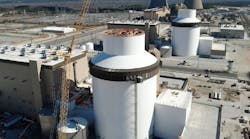ISO New England Inc., the operator of the New England power system and wholesale electricity markets, has issued its 2017 Regional System Plan (RSP17), the biennial report that provides the foundation for long-term power-system planning in New England. RSP17 was approved by the ISO New England board of directors.
The comprehensive report details power system needs for the next 10 years, through 2026, and how these needs can be addressed. RSP17 discusses:
- Forecasts of annual energy use and peak demand from 2017 to 2026
- Strategic issues facing the region, including the integration of variable energy resources, such as wind generation and solar photovoltaic (PV) installations, resource retirements and additions, and fuel security risks
- The need for resources, including generators and demand-side resources, to meet consumer demand for power and replace retiring power plants
- How the region’s power system can continue to address reliability concerns by identifying areas of the grid where resource additions or transmission upgrades are needed
- Coordination of New England’s planning process with those of neighboring regions
“The Regional System Plan continues to be an important informational resource for the region,” said Gordon van Welie, president and CEO of ISO New England Inc. “New England’s energy system is in the midst of a major evolution toward a cleaner, hybrid grid, which will include renewable technologies such as wind and solar, and conservation measures such as energy-efficiency, as well as traditional resources, such as natural-gas-fired generation. ISO New England looks forward to working with stakeholders to address the changing state of the system and plans for addressing future issues as the system continues to evolve.”
RSP17 Highlights
Long-term load forecast—With growing levels of PV and energy-efficiency resources, the 10-year forecast of demand shows total annual use of electric energy declining by 0.6% per year, with the summer peak declining 0.1% annually by 2026 under normal weather conditions. Without PV and EE, the baseline forecast shows that annual energy consumption would grow by 0.9% annually, and peak demand would grow by 1.0%.
Capacity resources—The eleventh Forward Capacity Market auction (FCA #11), held in February 2017, procured sufficient resources to meet resource adequacy criteria through 2021, with about 264 MW of new generation and 640 MW of new demand-side resources. These numbers include 515 MW of new energy efficiency, 6 MW of new wind, and 5 MW of new solar.
Generator retirements and resource development—From 2010 to summer 2020, power plant retirements will total approximately 4,800 MW. The report notes that older oil- and coal-fired and nuclear generators are at risk of retirement due to economic and environmental pressures, and these retiring resources are likely to be replaced by natural-gas-fired power plants and renewable energy resources such as wind and solar. Further, as of April 2017, about 12,899 MW of resources had applied to connect to the region’s high-voltage power system though, historically, the interconnection queue has had an attrition rate of 68% of the megawatts proposed. The most reliable and economic place for resource development remains in southern New England near load centers.
Fuel-security concerns—Although the region is projected to have sufficient resources to meet capacity requirements and adequate transmission facilities to meet reliability criteria, fuel security remains a primary issue the region must resolve to meet its energy-supply needs. The limited availability of the natural gas transportation infrastructure to supply gas to generating units can present fuel-security risks to the region, especially during winter operating conditions, even as the use of natural gas as a primary fuel for generating units is projected to grow. The ISO is conducting an operational fuel-security analysis to quantify the region’s risk and the results will be discussed with stakeholders in 2018.
Solar—PV resources totaled 1,918 megawatts (MW) nameplate capacity (referring to the total amount a resource could produce running at 100% of its capability) by the end of 2016. ISO New England’s multistate forecast of PV growth projects that by the end of 2026, PV will grow to 4,733 MW in nameplate capacity and produce about 6,200 gigawatt-hours of energy that year. PV resources are estimated to reduce summer peak loads by 575 MW in 2017, with that number climbing to 1,035 MW in 2026. The growth of behind-the-meter resources, which the ISO cannot observe or dispatch in real-time, continues to add complexity to system operations.
Wind—New England currently has 1,300 MW of installed wind facilities, and about 5,400 MW more have been proposed as of April 2017. Most of the wind projects constructed or under consideration are in remote areas of the region where the wind conditions are good, but where the transmission network was built to serve low levels of area load and is currently at its performance limit. These conditions have led to a backlog of projects in northern and western Maine, given the need for wind developers to build costly transmission upgrades to connect their projects to the regional grid. The ISO has developed and filed with the Federal Energy Regulatory Commission a set of revisions to the interconnection procedures aimed at resolving this backlog by allowing project developers to share the costs of upgrades. Further, as the amount of wind generation grows, operational forecasts and dispatch control of this variable energy resource take on increasing importance.
Battery storage and advanced technologies—Energy-storage technology is developing rapidly, with increasing levels of participation in the wholesale markets expected over the next decade as the technology’s costs decline. The region’s first grid-scale battery system, a 16 MW facility at Yarmouth Station in Maine, was placed on line in 2016. The ISO continues identifying and addressing other issues to prepare for the large-scale development of energy-storage and other advanced technologies.
Transmission upgrades—From 2002 through June 2017, 730 transmission projects to address reliability needs were put into service in the six New England states. These projects represent an $8.4 billion investment in new infrastructure that improves system reliability and reduces costly congestion on the high-voltage transmission system.
Transmission planning—As of June 2017, approximately $4 billion in transmission investment for reliability was planned. The overall need for major transmission projects for reliability is expected to decline over the 10-year planning horizon, but integrating large-scale renewable energy resources are potential drivers for future transmission investments.
Interregional planning—The ISO participates in national and interregional planning activities, developing coordinated system plans with other regions. Particularly close coordination continues with the New York ISO and PJM, the system operator for all or parts of 13 states and the District of Columbia in the mid-Atlantic region.


